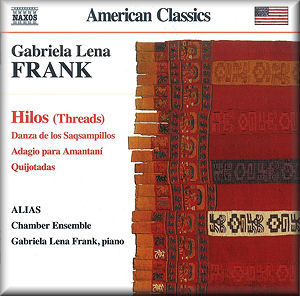 |
 |
|


alternatively
CD: MDT
AmazonUK
AmazonUS
|
Gabriela Lena FRANK (b. 1972)
Hilos (Threads) for clarinet, violin, cello and piano (2010)
[27:19]
Danza de los Saqsampillos for two marimbas (2000/2006) [6:55]
Adagio para AmantanÝ for cello and piano (2007) [9:43]
Quijotadas for string quartet (2007) [22:45]
 Gabriela Lena Frank (piano)
Gabriela Lena Frank (piano)
ALIAS Chamber Ensemble
rec. 22-23 May and 1-2 August, 2010, Turner Recital Hall, Vanderbilt
University, Nashville, Tennessee, USA
 NAXOS 8.559645 [66:41]
NAXOS 8.559645 [66:41] 
|
|
|
Gabriela Lena Frank is a pianist-composer with fascinating
ethnic roots, and she explores that heritage in much of her
music. Her parents are from Peru and Lithuania and she’s of
Jewish descent. The mixture makes for a unique blend, of which
the single biggest component is Peru’s native folk-musical styles
and rhythms. The centerpiece of the CD is a half-hour chamber
work, Hilos (Threads), the threads of which are (one
imagines) the four instruments, which appear together and in
nearly every available combination of two.
Thus in the first movement of Hilos we get all four instruments
together — piano, violin, cello, clarinet — which is reduced
to clarinet with a very characterful pizzicato cello in the
second dance and a rhapsodic violin solo urged on by piano in
the third. The music is all richly evocative of Peruvian folk-dance,
with stamping rhythms and impressive virtuosity required. There
is melody, but not in the western sense. Readers here are not
likely to whistle Hilos, except maybe the toe-tapping
“Juegos” for violin, cello, and clarinet. The musical language
has impressive internal logic. And a lot of this is pure pleasure,
too, like the almost jazzy piano trills in the final movement.
I’ve listened repeatedly with great pleasure: the tribes of
Peru might not have heard anything quite like this - unless
the sidelong glance at Stravinsky in the fourth dance is a happy
coincidence - but they and we ought to be happy to.
The Danza de los Saqsampillos might be the easiest work
to like on the program: arranged for two marimbas from a two-piano
original, it’s a very catchy dance that really realizes the
sound potential of the instruments. I’m not sure I’d enjoy it
as much on piano, not without the back-and-forth between the
dueling marimba players and the evocative sounds the instrument
conjures up.
The Adagio para AmantanÝ is a much more withdrawn, introspective
work, and though it’s scored for cello and piano they take turns
in their laments; if they play together at all it is only for
a few seconds. I should note that, according to Gabriela Lena
Frank’s wonderful booklet note, AmantanÝ is an island: “Situated
in the middle of Lake Titicaca between Per˙ and Bolivia, the
island is both beautiful and frighteningly barren, and its inhabitants
depend on one another deeply in order to survive the cold and
arid climate.”
The disc then concludes with Quijotadas, a suite for
string quartet based on the Don Quixote: there’s a tripping,
lively seguidilla at the beginning (adventures at the inn?),
a portrait of the Don’s descent into madness, and another descent
portrait, of his entry into the cave, a movement which has a
suitably ghostly and mysterious conclusion. The best parts of
the quartet - including that outstanding seguidilla - are really
terrific, though I wouldn’t rate this as highly as the Danza
or Hilos.
That is, however, very high indeed. This is wonderful music,
and whether you call it “American” music, or “Latin-American”
music, or folk-inspired, or whatever, Gabriela Lena Frank has
a distinctive, interesting voice, and she writes extremely well-crafted
music that’s a great pleasure to hear. Her piano contributions
here are very good, the ALIAS Chamber Ensemble is up to all
of Frank’s technical demands and complex rhythms - listen to
the exquisite pizzicatos in the seguidilla - and the recorded
sound is exemplary. What more can I say? This is a release to
be excited about.
When this CD is loaded into a computer, the Gracenote database
identifies its genre as “rock.” I’d object but, hey, Danza
de los Saqsampillos rocks.
Brian Reinhart
|
|

